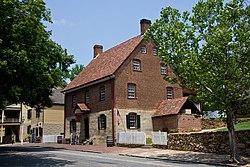Old Salem
|
Old Salem Historic District
|
|
 |
|
| Location | Between Race Street, Old Salem Road, Horse Street and Brookstone Avenue and including parts of God's Acre and buildings along the east side of Church Street, in Winston-Salem, North Carolina |
|---|---|
| Built | 1766 |
| Architect | Unknown |
| Architectural style | Germanic in early years, slowly shows English/American influence (i.e., Federal and Greek Revival period architecture) |
| NRHP Reference # | 66000591 |
| Significant dates | |
| Added to NRHP | November 13, 1966 |
| Designated NHLD | November 13, 1966 |
Old Salem is a historic district of Winston-Salem, North Carolina. It features a living history museum (operated by the non-profit Old Salem Museums & Gardens, organized as Old Salem Inc.) that interprets the restored Moravian community. The non-profit organization began its work in 1950, although some private residents had restored buildings earlier. As the Old Salem Historic District, it was declared a National Historic Landmark (NHL) in 1966. The district showcases the culture of the Moravian settlement in North Carolina during the 18th and 19th centuries, communal buildings, churches, houses, and shops.
Two buildings are individually designated as NHL: the Salem Tavern and the Single Brothers' House. Additional buildings and properties have been added to the National Register that expand the historic area (see St. Philips Moravian Church below, Single Brothers Industrial Complex Site, and West Salem Historic District). Ownership of the buildings and land is divided among Old Salem, Inc., Wachovia Historical Society, private owners, Salem Academy and College, Home Moravian Church, and the Moravian Church Southern Province.
Salem was originally settled by members of the Moravian Church, a Protestant denomination that first began in 1457, out of the followers of John Huss (Jan Hus, 1369–1415) in the Kingdoms of Bohemia and Moravia, now part of the Czech Republic. In 1722, the exiles finally found protection on the estate of Count Zinzendorf, a Saxon nobleman, where he helped create the village of Herrnhut as their home. First settling in North America in Savannah, Georgia in 1735, they moved to Pennsylvania in 1740, where they founded several communities (Bethlehem, Nazareth, and Lititz). Because of development pressures, they looked for more space to create their church communities. Purchasing just over 98,985 acres (400.58 km2) from John Carteret, 2nd Earl Granville, one of the British Lords Proprietor, in the Piedmont of North Carolina in 1753, they sent groups from Bethlehem, Pennsylvania to begin construction. They founded the transitional settlement of Bethabara, North Carolina (translated as "House of Passage," the first planned Moravian community in North Carolina in 1753, in Bethania, North Carolina) in 1759.
...
Wikipedia
